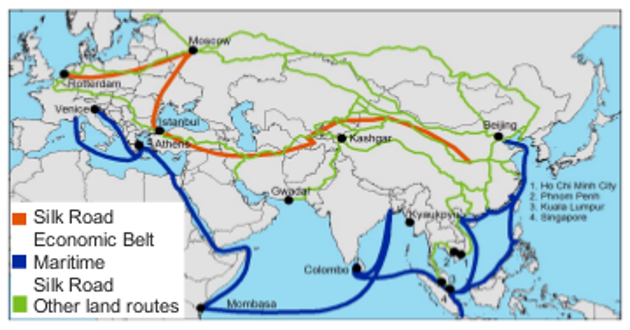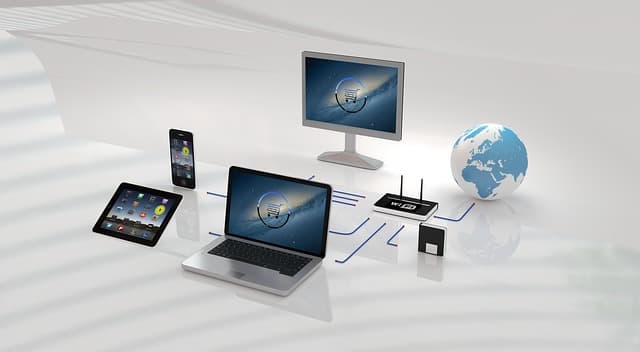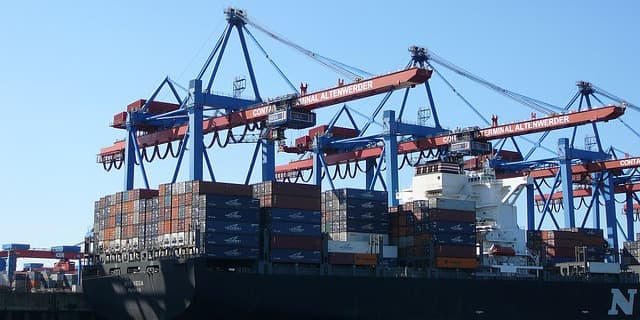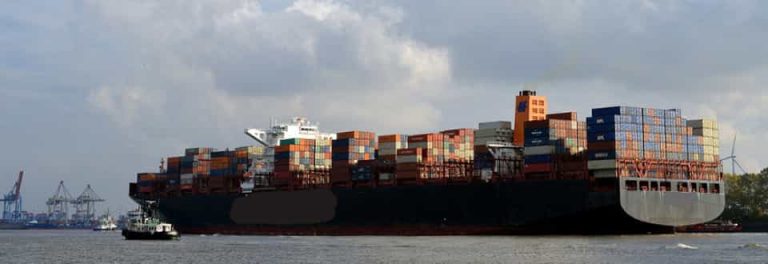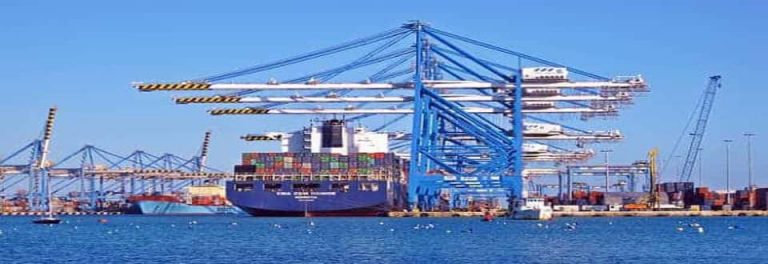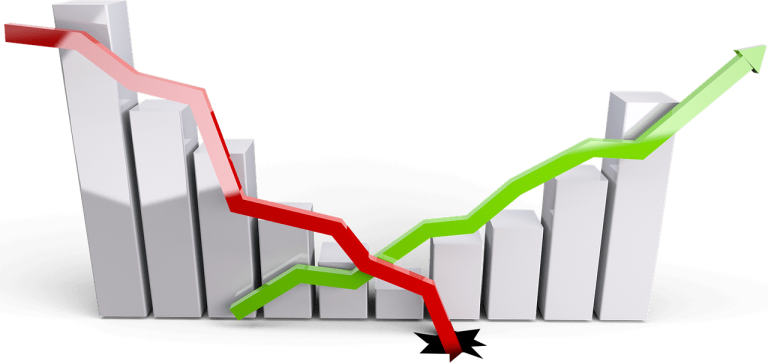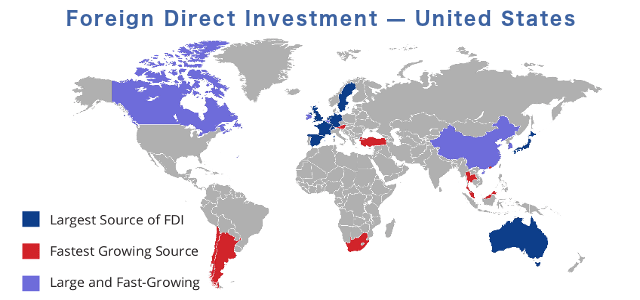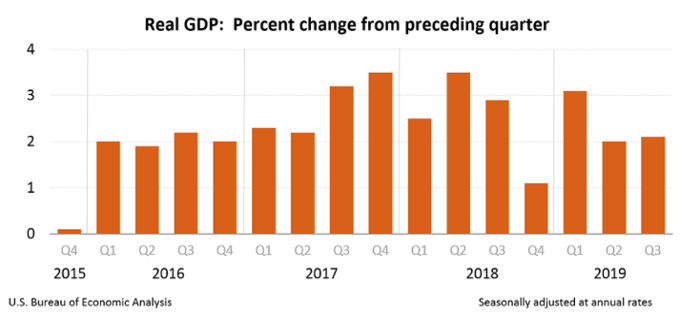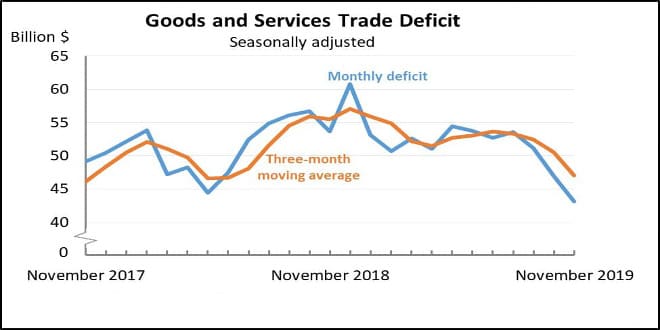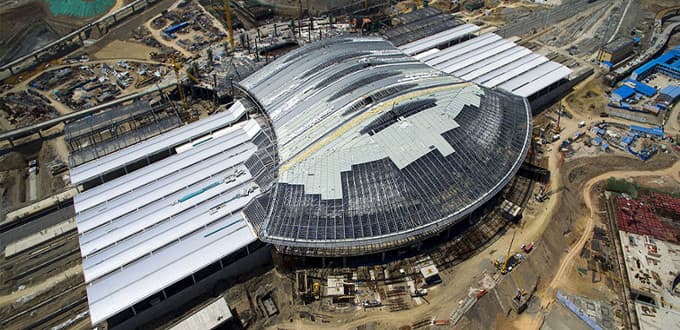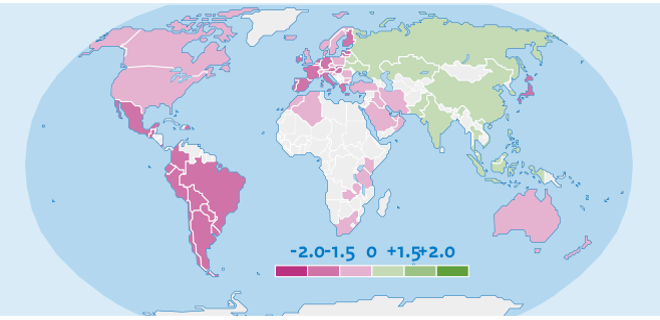Mobile Payments, eCommerce, and Virtual BankingThe Logistics of Global Trade & Commerce
Smooth Flow of Goods & Merchandise
Smooth Flow of Goods & Merchandise
Growth of Mobile Payments and Virtual Banking
Global Market Statistics & Trends
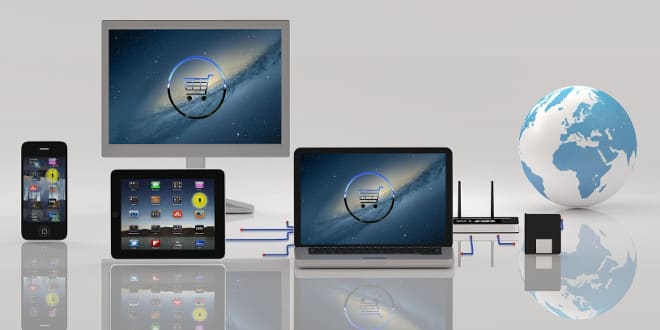
Mobile Payments, Virtual Banking, and other modes of mobile transactions—both at consumer and commercial level, are growing globally at an ultra fast pace—more so in Asia Pacific and other regions than in the United Stated. For any business that has global aspirations—and, all must have, it is more important now to understand this phenomena, and the underlying social trends and technologies propelling it.
Billion of users across the world—in particular in China and the Asai Pacific region, have adopted the Mobile Payment technology and its use is growing at a fast pace.
WeChat (a subsidiary of Chinese technology giant Tencent) and Alipay (a unit of the Alibaba, the king of the global wholesale trade) are the world’s two largest Mobile Payment platforms—Both with more than 1 billion active users each (as of April 2019). In China ‘Alipay’ and ‘WeChat Pay’ control more than 90% of the mobile payment market. Their user base is growing steadily all over world.
Banking—A Changing Landscape
It is a recognized facts that as the economies are moving away from cash, and entering into a digital commerce and financial system, many fundamental changes are occurring in how do we make or receive payments. For one, both the paper and plastic are vacating the spot for portable electronic devices, scanners, and other modes of conducting business – both online and on-spot.
The banks, as we know now—the brick and mortar edifices, may also be on their way out. The physical banks are already gearing up and adjusting accordingly for the change. The financial sector — be it the ‘BIS’ (Bank of International Settlement) OR the ‘SWIFT’, is already going through drastic overhaul and changes in the process of adopting new ways of handling global transactions.

It is quite feasible that in a short few years, the only physical banks still left standing will be the Central Banks of the nations and a few other specialized services institutions.
It is the era of the so called ‘FinTech’ industry and Virtual Banks—The complete digital banking system that encompasses the front end which the consumers see, the back end that bankers see through the servers and their admin control panels, and the middleware that connects all these nodes—customers/consumers, partners, and corresponding affiliates.
With the convergence of the Virtual Banking, AI, and the Blockchain Technology—Crypto Currencies like bitcoin etc, and peer to peer transactions, entrepreneur and business people have this new convenience factor to consider, and be ready to incorporate it into their business strategies and plans.
Mobile Commerce—An Idea Whose Time Has Come
Many of us are not aware that the concept of virtual banking and mobile commerce is not a new phenomenon. It is an ’old’ ideas whose time has finally come.
The History of Mobile Commerce:
Back in 1997 – on November 10 to be precise, at the Global Mobile Commerce Forum in London, UK, Kevin Duffey, Logica’s managing consultant for mobile innovation coined and defined the ‘Mobile Payment’, “the delivery of electronic commerce capabilities directly into the consumer’s hand, anywhere, via wireless technology.”
[Logica was a multinational IT and management consultancy company headquartered in Reading, UK. It was founded in 1969, and was acquired by CGI Group back in 2012.]
Kevin also explained that businesses might like to think of Mobile Commerce as “a retail outlet in your best customer’s pocket.” How right he was!
Mobile payment is the future that has already arrived. In most economies and markets, cash transactions – both the paper and plastic, is already a thing of the past, while others are in a transitional stage and the adoption is growing fast.
Global Mobile Payments—Transaction Share and Growth
Smart devices, online sales, and mobile payments are changing the habits and the way consumers find goods and services and pay for them. They are also forcing the businesses to adopt and change the way they accept, secure, and facilitate payments.
Back in 2016, Allied Market Research published a report titled, “Mobile Payment Market by Mode of Transaction, Type of Mobile Payment, and Application: Global Opportunity Analysis and Industry Forecast, 2017-2023”. According to the report, the mobile payment market in 2016 was valued at $601 billion, and it is projected to reach $4,574 billion by 2023 — The global mobile payment market is expected to grow at a CAGR (Compound annual growth rate) of close to 36% from 2018 to 2023.
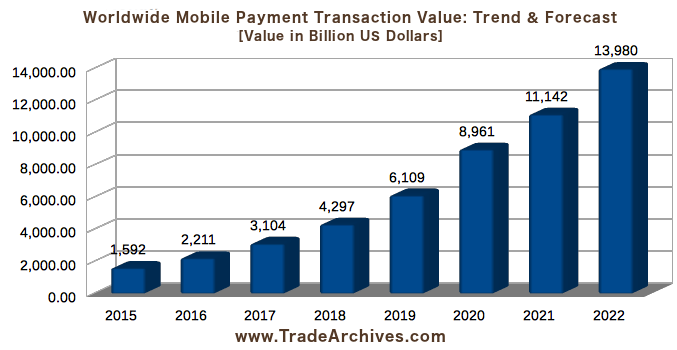
It was a tremendous growth projection. But, as we are observing now, the growth is expected to surpass those early projections. This acceleration of growth is owing in particular to increasing adoption and demand for mobile payment in APAC (Asia-Pacific) region — thanks to its large customer base and the popularity of mobile wallets such as Alipay and WeChat, followed by the Americas and EMEA (Europe, the Middle East and Africa) markets.
Within the various modes of Mobile Payments, the NFC (Near-field communication) transactions are expected to hold the largest market share — to the tune of close to 30% of the total mobile payments.
The Asia-Pacific mobile payment industry segment is anticipated to grow at the highest rate during the forecast period.
The Largest eCommerce and Mobile Payment Market—China
China, the world fastest growing and largest economy by the Purchasing Power Parity, is leading the world in online payments. The number of people in China buying goods and services using smartphone apps that provide mobile-payment services is growing at an astoundingly fast rate.
When thinking of new markets for the products and services and expanding the business, one more point to consider is that China is the world’s largest market for almost any product, and, at the same time, the largest trading partner for the majority of the world’s economies. Whatever trends or technologies emerging there, we have to keep an eye on it. The Adoption of mobile payments technologies is one of such trends that we need to be aware of.
According to an earlier report by iResearch Consulting Group, which measures and analyzes online data in China, the gross merchandise volume (GMV) of online payments in the country had reached 57.7 trillion yuan (US $8.6 trillion) in 2016. That amounted to about 50 times the GMV of similar transactions in the United States, which was estimated by market research firm Forrester Research at US $112 billion.
The data compiled at the end of 2018, showed that the China’s Mobile Payment transaction volume actually had reached 277.4 trillion yuan ($41.51 trillion) in 2018. That is up more than 28 times from five years ago, according to the People’s Bank of China.
The total number of transactions made via mobile payment platforms in China had already surged to 60.53 billion in 2018, up from 1.67 billion back in 2013. As per iResearch’s later reports, Mobile Payments Transaction Volume in China had Risen to over 23% YoY in 2019.
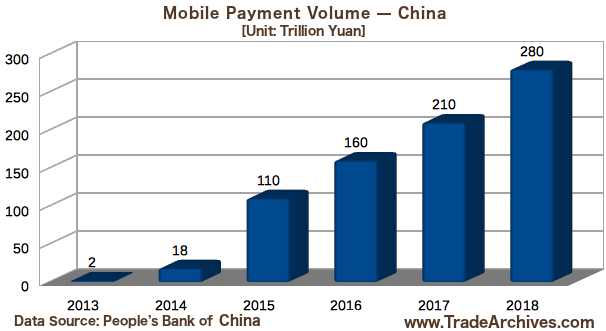
With the introduction of Alipay back in 2004, a major transition from cash to mobile payments got initiated. Before the Alipay, Union Pay was the closest mode of payment to credit or debit cards that Chinese consumers could use. After the Alipay, and, later, Wechat Pay broke ground, the landscape of the mobile payment got fertile and these two pioneering companies became the dominated players—snatching 90 percent of the payment systems market in China.
These two Chinese giants: Alibaba, through its Ant Financial and its Alipay payments platform, and Tencent, through its WeChatPay platform, dominate the Chinese mobile payment payments market.
Today, hardly any merchant wants to accept cash. Even small hawkers selling goods on the street in major Chinese cities don’t want cash. Almost all POS payments and online purchases are done by phone—Virtually everything is paid for by phone and with the use of a QR code—even gratuities are paid in this manner.
This mode of payments is fast and convenient eliminates clumsy point-of-sale terminals, and cuts down on the cost of associated transaction fees as the middle-man is removed. The process of accepting mobile payment is simple; A seller can simply print out the QR code and begin accepting payments. And, to top it all off, these mobile payment platforms are costless to both the merchant and consumer.
No doubt, WeChat Pay and Alipay have hundreds of millions of daily users in China. As of the end of 2019, Alipay alone—along with its affiliates, had more than 1 Billion global users.
The adoption of the technology and the stability of the system is obvious with the fact that a record 823 million people in China used WeChat to send and receive the monetary gifts commonly known as “hongbao” on the Lunar New Year Day (February 5, 2019).
Mobile Payment Markets—The US, Europe, and Asian Economies
Asian Economies:
Among the relatively smaller economies in Asia, Vietnam is the fastest-growing market in mobile payments. With 24 percent increase from 2017, 61% of its consumers are using such services. In Thailand, the overall usage of mobile payment was 67 percent in 2018.
The US:
The adoption of both the mobile payments and mobile banking is slow in the US—major mobile payments had adoption rates of less than 10%. And, there is a reason for it:
Both the WeChat Pay and Alipay platforms work on any type of phone. In contrast, in the United States mobile payment services are only compatible with certain operating systems and phones. For example; users with Android-based phones can’t use Apple Pay, and those with Apple iPhones can’t access Google Pay. These mutually exclusive platforms and technologies are a major hindrance in the adoption of mobile payments in the United States.
No doubt, the adoption of Mobile Payment in the US is slow. Despite having one of the highest rates of early smartphone adoption, it is trailing the rest of the world when it comes to the mobile payment.
The leaders in the Mobile Payment service in the US – as of January 2019, are:
— Apple Pay with 380 million users
— PayPal with 260 million users
— Amazon Pay with 50 million users
— Google Pay with 24 million users
Europe:
In Europe, the home to some of the most cashless societies in the world, the mobile payment adoption is going up fast. 77% of Europeans are already using mobile banking and/or mobile payments. And, 92% of tech-savvy millennials expect to be using mobile payments by the year 2020.
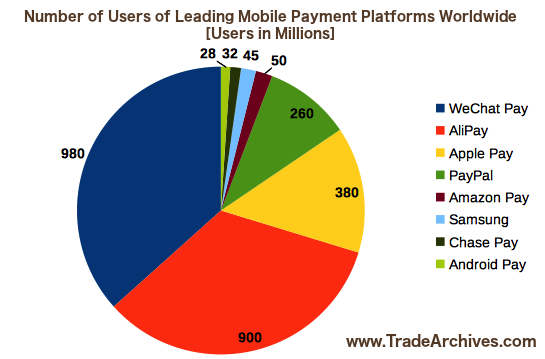
Latin America:
Though, a lot of people in Latin America are disconnected from the banking system, still the adoption of Mobile payment is increasing across Latin America. As the new mobile payment services are emerging from Peru to Columbia, people are moving into mobile payment. Brazilian digital payment services provider ‘PagSeguro’ reported a 107% revenue increase in the first quarter of 2018 in comparison to the last year.
Africa:
The slowest to adopt the mobile payment is, of course, in Africa. But, as the political stability and resulting peace and security all across the continent is slowly getting hold, a boom in reconstruction, commerce, and business activities is already opening new opportunities and vistas for the entrepreneurially minded. It will not be long that Africa will also catch up with the world.
The Digital Age || Global Business, eCommerce, Banking, Mobile Payments, and Mobile Wallets
Banks and financial institutions provide the ‘back-end’ settlements for all the transactions that are conducted via the mobile payment platforms. These institutions have also adopted the technology and provide a vital link to facilitate the mobile payments. Through bankcards—credit cards and debit card etc, banks provides a connection between the user’s bank account and the mobile payment account at the provider’s platforms.
Mobile Wallet || Connecting the Banks, Users, and Mobile Payments:
Mobile Wallets is the tool that links the two accounts—the bank account and mobile payment account. Mobile wallet – in essence, is a virtual wallet that stores payment card information on user’s mobile device.
Mobile Wallet itself is simply a smartphone app that links the user’s bank account with the mobile payment platforms like AliPay, WeChat, Apple Pay, Google Pay etc. Mobile wallet stores this information and links it via a personal identification format such as a code, a key, QR, or an image of the user to the stored card.
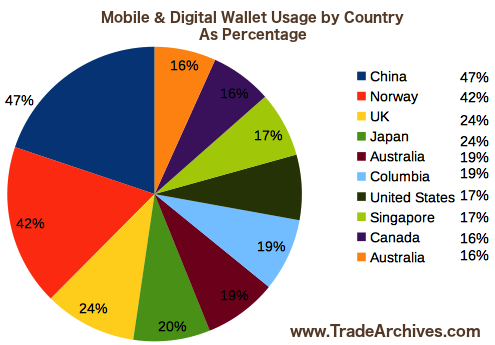
It is the ease of use, and the zero cost to both the merchants and users, that is propelling the growth of mobile payments. The projections of the worldwide growth of mobile payments are simply mind boggling. And, if the trend of the growth over the past few years is any indicator, we will see the actual numbers even higher than the forecast. This trend is certainly an opportunity for the entrepreneurs and businesses.
Digital/Virtual Banking, Mobile Payments, and all the other emerging technologies like Block Chain are the realities of the new global financial landscape—They have opened door to opportunities that never existed before.
元 $ € ¥ ₿
Information
Reports & Analysis
To Help Evaluate
The Potentials For
Business
&
Investment
In an Interconnected
World
-
The Belt and Road Initiative & Made in China 2025
Riding high on the fast tracks of the Belt and Road Initiative, Made in China 2025 is rapidly making inroads into the countries... Fierce competition from Chinese companies...
-
MIC 2025 || The Changing Landscape of Chinese Economy
It was in 2015 that China unveiled its Made in China 2025 (MIC 2015) project. Since then, Chinese economy is metamorphosing and changing at a breakneck pace...
-
Top Freight Forwarders by Country
Large scale ‘local area’ Freight Forwarders listed here, through their contacts and arrangements, also provide services on a global scale. Their main strength though lies in...
-
Most of the Top Global Freight Forwarders listed here serve all the major ports across the Globe, and, through relationships with their business partners, also provide a full suite of...
-
Glossary: Shipping, Freight, & Supply Chain Logistics
Like any other professional field, the shipping/freight industry has its own unique set of terminology—A rather extensive and complex one. Here we have compiled the Glossary of the most useful...
-
Global Foreign Direct Investment—Inward Flow
A comprehensive and historical Global FDI Inward-Flow Data spanning the period of 2000—2018. The data is compiled by grouping and associating a variety of economies together; by the state of...
-
The new phase of economy in China is an opportunity for the businesses. The emphasis is now on raising the living standards of masses, implementing supply-side reforms, and opening up...
-
Top 50 Container Ports in The World
Large Capacity & Super Busy Container Ports in a country are the pointers of country’s economic potentials...Bulk of the world trade in goods—more than 90% of it...
-
Supply Chain | Definition and Objectives
Supply Chain can be viewed as a network connecting a business to its suppliers and distributers to facilitate the production, processing, and distribution of its products to the consumers. It incorporates...
-
Global Business | Supply Chain & Logistics
With the technology—and global eCommerce platforms like Ali Baba, JD.com, Tancent, Kaola, Lazada, WooCommerce, VTEX, and Shopify etc, it is easier to sell products and services Globally.
-
Shipping Logistics | The Role of Service Providers
The logistics of getting the goods delivered to faraway destinations—especially to foreign markets, is a complex business. It requires the services of outside entities to...
-
Freight Forwarders | Role in Global Commerce
Freight Forwarders specialize in taking care of the entire process for their shippers | from warehousing to the shipping of their merchandise. They act as an agent and intermediary...
-
Real GDP | Nominal GDP vs GDP PPP
In evaluating and analyzing global investment opportunities and, also in the business decision making process, we need to know the actual comparative state of the economies of various countries and...
-
With the perspective of charting course for the expansion of business or investment, an analytical review of the ‘real value’ of a nation’s/region’s GDP is essential. To this end, an understanding of the methodologies used in...
-
New Global Business Order—The Global Information Stage
Whatever the business be, it has to be ready to play on the Global Stage. It is the global arena. The Supply-and-Demand chain is global. ..There is no business that can be considered as purely a...
-
Global Real GDP Growth Rate—And Forecast
Real GDP provides an inflation-adjusted measure that reflects the true value of all goods and services produced by an economy in term of real value of...
-
Foreign Direct Investment Inward Flow in The US—A Global Perspective
The Inflow of FDI in the U.S. was up by US $50 Billion in the 3rd quarter of 2019. FDI plays an essential role in the economic growth, creating jobs, and driving exports...The tables present...
-
US Gross Domestic Product: 2019—By Quarters
Real US GDP increased at an annualized rate of 2.1 percent in the 3rd quarter of 2019—that was up from the second quarter. Real gross domestic income (GDI)...
-
Foreign Direct Investment—Impact and Analysis
Foreign Direct Investment (FDI) plays an important role in the development and growth of any country’s economy - especially the developing countries. But, in actual practice...
-
Foreign Direct Investment and Business in China
China is establishing itself as the Model Destination for FDI inflow and a hub for corporate relocation and R&D...
-
US Global Trade & Top Trading Partners | Year-to-Date
Since hitting the peak in November 2018, U.S. global trade deficit in goods and services has been on the decline. But, the declining trends in both Imports and exports...
-
The Growth of Mobile Payments and Virtual Banking—A Global Perspective
Mobile Payments, Virtual Banking, and other modes of mobile transactions - both at consumer and commercial level, are growing globally at an ultra fast pace — more so in China and Asia Pacific and...
-
Belt and Road Initiative—Objectives & Achievements
As of the end 2019, the BRI — a project to interlink the global economies with China, includes 140 countries—encompasing more than 2/3 of the world’s population. The trade on BRI is...
-
In 2019 US imports from China dropped more than 12.5 percent to US$456 billion (Source: United States’ Census Bureau ) while China’s imports from the US dropped to US$122.7 billion...
-
Humans by nature - or by need, are traders. We trade our work, services, produce, or products for money. Then, we exchange that money for the goods and services that we need. Any excess/leftover money is either directly invested or deposited in the banks—thus, making the money to recirculate in the economy again.
Information, Data, and Reports organized alphabetically By Topic:
Global Business
Investment
Trade & Commerce
Always The Key to
to Wealth & Prosperity
Since before the days of
Camel Caravans & Sailboats


